This post was last updated on March 5th, 2023
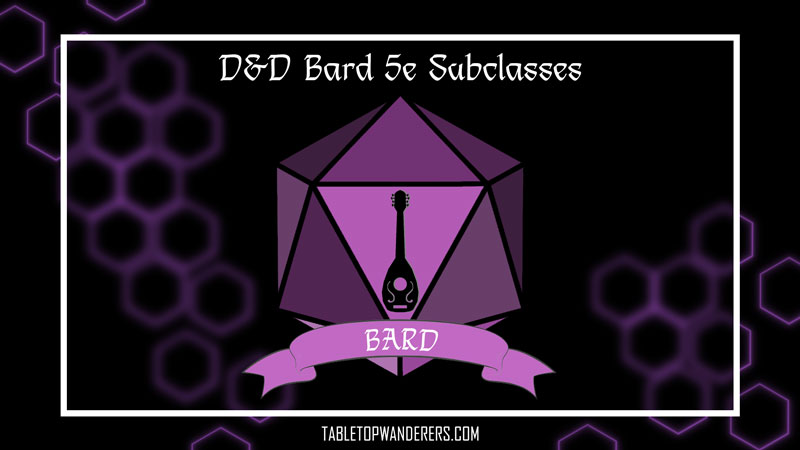
Hi fellow gamer and welcome to another Dungeons & Dragons article, this time focused on the Bard 5e subclasses called Bard Colleges.
In my previous Bard level-up guide article I said how I find the level-up process to be one of the most enjoyable parts of any RPG and one of the nuances I prefer when I level up is to find ways to differentiate my character from the rest of the party, which is when subclasses come into play.
The Bard could easily get mistaken for a fool character whose only role in a party would be playing some instruments and singing songs.
That is a generalization of an awesome class that could actually make the entire party really shine.
There are currently 8 Bard 5e subclasses across different D&D manuals.
For each of them, I’ll write a general overview and at the end of the article, you’ll also find the Bard 5e subclasses ranked following my personal taste which takes multiple factors into consideration, with the role-playing and playstyle potential of the class in the first place.
This post may contain affiliate links. If you click through and make a purchase, I will get a commission at no extra cost to you. See our Affiliate Disclosure.
D&D Bard 5e Subclasses
- College of Creation Bard 5e
- College of Eloquence Bard 5e
- College of Glamour Bard 5e
- College of Lore Bard 5e
- College of Spirits Bard 5e
- College of Swords Bard 5e
- College of Valor Bard 5e
- College of Whispers Bard 5e
College of Creation Bard 5e
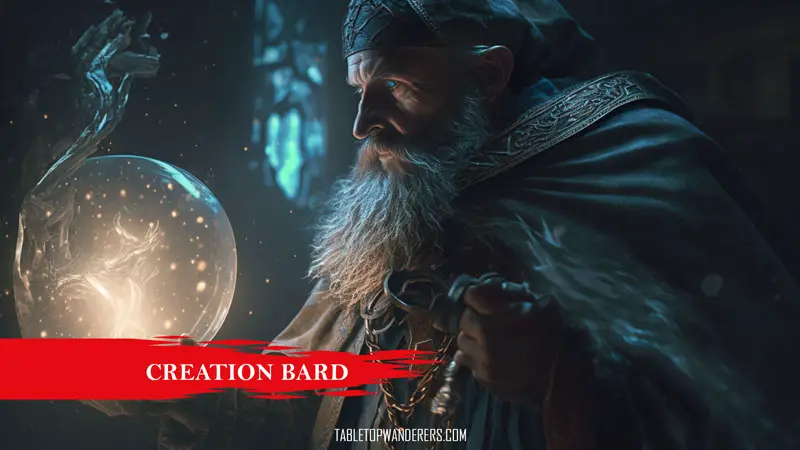
Subclass Overview
The universe, according to bards from this College, is an artistic masterpiece made by the first gods and dragons. The harmony included in that artistic work is still audible today, and it is known as the Song of Creation.
These bards draw from that song through dance, music and poetry.
D&D Manual: Tasha’s Cauldron of Everything.
Creation Bard Main Features
Mote of Potential – 3rd level
Whenever you cast your Bardic Inspiration upon a creature, you’ll be able to utter a note from the Song of Creation in order to create a small mote of potential.
This intangible and invulnerable mote will orbit around the inspired creature and it’ll give an additional benefit when that creature decides to use the Inspiration die.
The effects are different depending on whether the die benefits an ability check, an attack roll or a saving throw:
- Ability check: you can roll 2 dice and choose which roll to use, rather than rolling just 1 die.
- Attack roll: after you roll the inspiration die to add a bonus to your attack roll, the target of the attack and each creature within 5 feet of you must succeed in a CON saving throw; if they fail they’ll be hit with additional damage equal to the number you rolled on the inspiration die.
- Saving throw: after rolling a saving throw, you gain temporary hit points equal to the inspiration die roll plus your CHA modifier.
Performance of Creation – 3rd level
You can create one nonmagical object of your choice in an empty area within 10 feet of you by using an action.
The object must be medium or smaller, with a maximum gp value of 20 times your bard level.
Animating Performance – 6th level
Similarly to the performance of creation feature, you can use an action to animate a large or smaller nonmagical item within 30 feet of you that isn’t
being worn or carried.
This item will obey your commands and will last for 1 hour.
Creative Crescendo – 14th level
This is a feature that boosts your Performance of Creation, in fact, you can now create more than one item at once and you are no longer limited by the gp value.
Party Role
Buffing Support.
College of Eloquence Bard 5e
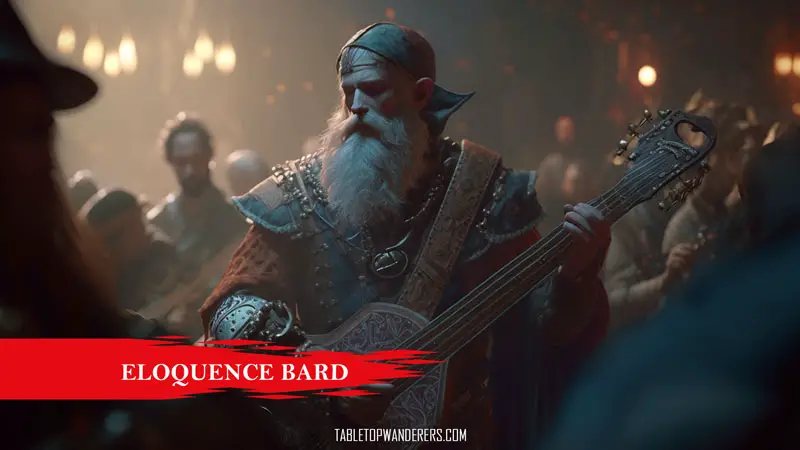
Subclass Overview
Members of the College of Eloquence are experts in public speaking.
Thanks to their ability to flawlessly blend logic and theatrical wordplay, they can easily appeal to the emotions of whom listen to them.
D&D Manual: Tasha’s Cauldron of Everything.
Eloquence Bard Main Features
Silver Tongue – 3rd level
You always say the right thing at the right time, and this allows you to treat a d20 roll in Persuasion or Deception check of 9 or lower as a 10.
Unsettling Words – 3rd level
After choosing a creature you can see within 60 feet of you, you can roll one of your Bardic Inspiration die.
That creature must subtract that number from the next saving throw it makes before your next turn.
Unfailing Inspiration – 6th level
If a creature fails an ability check, attack roll or saving throw after using one of your Bardic Inspiration dice, the creature can keep that die.
Universal Speech – 6th level
You can choose one or more creatures (equal to your CHA modifier) and they can comprehend any language you speak for 1 hour.
Infectious Inspiration – 14th level
You can use your reaction to encourage a creature that can hear you within 60 feet of you by giving it a Bardic Inspiration die without using any of your Bardic Inspiration uses, if a different creature adds one of your Bardic Inspiration dice to its ability check, attack roll, or saving throw and the roll succeeds.
Party Role
Buffing Support.
College of Glamour Bard 5e
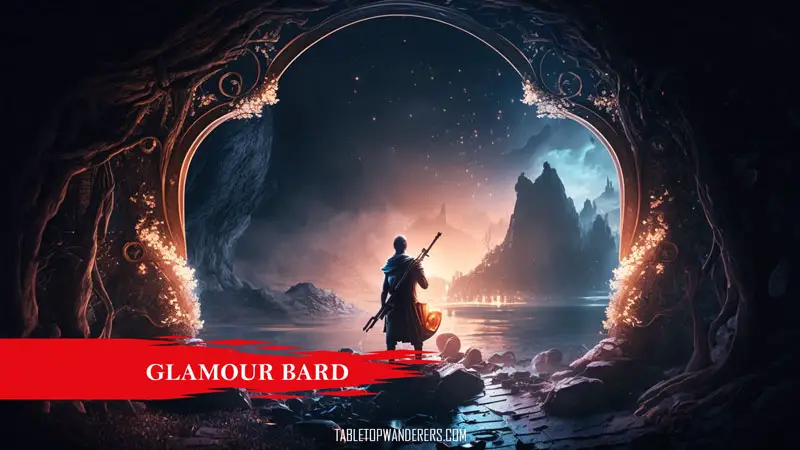
Subclass Overview
The College of Glamour is the home of bards who learn to use their magic to delight and captivate others, and they are regarded with a mix of awe and dread at the same time.
Evil bards from this college could turn people into thralls, whereas brave bards utilise this ability to cheer the oppressed and defeat the oppressors.
D&D Manual: Xanathar’s Guide to Everything.
Glamour Bard Main Features
Mantle of Inspiration – 3rd level
You can use one of your Bardic Inspiration dice to grant yourself a marvellous appearance that has the effect of giving your allies 5 temporary hit points.
Enthralling Performance – 3rd level
After performing for at least 1 minute, you can choose humanoid creatures (the number depends on your CHA modifier) that saw and listened to your performance.
They have to succeed in a saving throw or they will be charmed by you for 1 hour.
Mantle of Majesty – 6th level
Using your bonus action you can cast the spell command without using any of your spell slots, and if the creature you using the command onto is already charmed by you, its saving throw fails immediately.
Unbreakable Majesty – 14th level
As a bonus action, you can assume a magically majestic presence for 1 minute and any creature that attacks you have to make a saving throw.
If the saving throw fails you won’t be attacked and the attacker must choose another target or waste the attack; if the saving throw succeeds the attacker will have disadvantage on any saving throw against your spells on your next turn.
Party Role
Offensive Support.
College of Lore Bard 5e
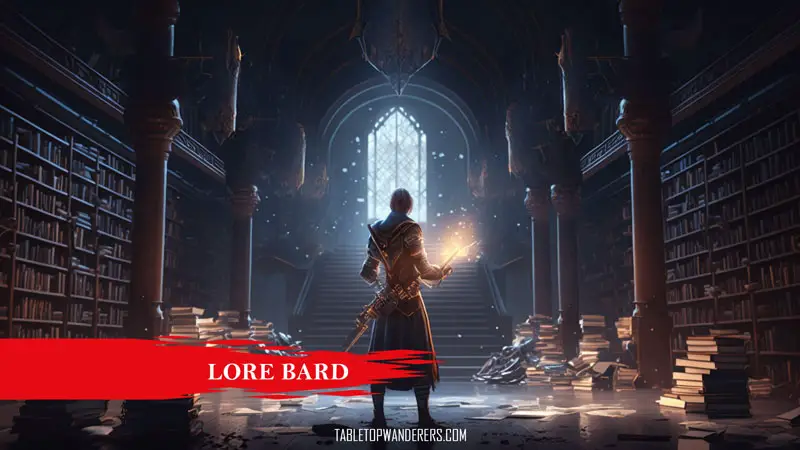
Subclass Overview
The College of Lore’s bards are knowledgeable about most topics because they have gathered information from a variety of sources, including academic texts and folklore.
These bards use their talents to enthral audiences, whether they are performing intricate compositions in royal palaces or traditional songs in taverns.
Members of the college convene in libraries and occasionally in actual colleges with classes and dorms to discuss their stories.
They also get together at celebrations or state events, when they may dispel lies, expose corruption, and make fun of arrogant leaders.
D&D Manual: Player’s Handbook.
Lore Bard Main Features
Bonus Proficiencies – 3rd level
You get to choose three skills of your choice.
Cutting Words – 3rd level
When a creature you can see makes an attack roll, an ability check or a damage roll, you can use your reaction to roll a Bardic Inspiration die and subtract the number rolled from the creature’s roll.
Additional Magical Secrets – 6th level
You can choose 2 spells of your choice from any class, but they have to be of a level you can cast.
Peerless Skill – 14th level
When you make an ability check you can roll one of your Bardic Inspiration dice and add the number to the ability check.
Party Role
Versatile Support.
College of Spirits Bard 5e
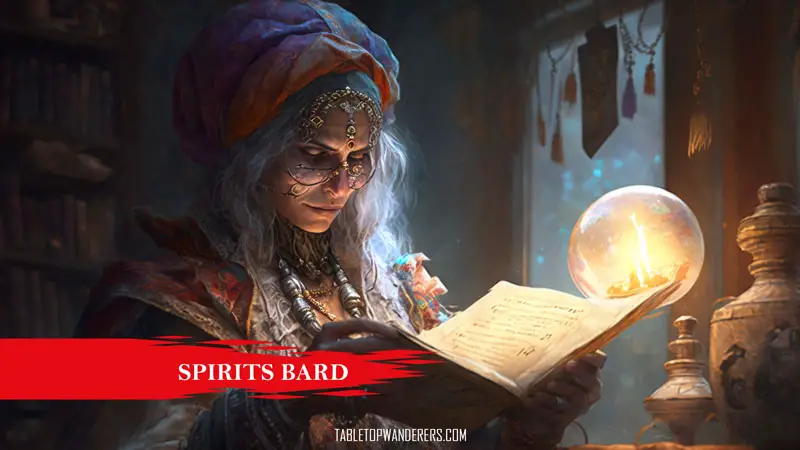
Subclass Overview
The College of Spirits’ bards search for stories that have inherent power, whether they are legends, history, or fiction, and they make their themes come to life.
These bards summon spiritual representations of strong forces using arcane devices in order to once more alter the course of history.
However, because they are unpredictable, these spirits aren’t always completely within the bard’s control when they are summoned.
D&D Manual: Van Richten’s Guide to Ravenloft.
Spirits Bard Main Features
Guiding Whispers – 3rd level
You learn the guidance cantrip, which has a range of 60 feet for you and doesn’t influence the number of bard cantrips you know.
Spiritual Focus – 3rd level
You can use these objects as a spellcasting focus for your bard spells: a candle, crystal ball, skull, spirit board or tarokka deck.
Starting from the 6th level, whenever you use the Spiritual Focus to cast a bard spell that deals damage or regenerates hit points, roll a d6. You then get a bonus to one of the spell’s damage or healing rolls equal to the number rolled.
Tales from Beyond – 3rd level
You can connect with spirits who use you to convey their tales.
While holding your Spiritual Focus, you can then roll on the Spirit Tales table using one of your Bardic Inspiration die as a bonus action to find out which tale the spirits want you to tell.
Each of them has a different effect and this effect is applied to one of the creatures you can see within 30 feet of you.
Spirit Session – 6th level
You receive extraordinary insight from the spirits and using your Spiritual Focus you can perform an hour-long ritual with any creatures who wish to join you. up to a number that equals your Proficiency bonus (it can be done during a short or long rest).
You temporarily learn one Divination or Necromancy spell from any class at the conclusion of the ritual, and that spell will last until your next long rest.
Mystical Connection – 14th level
Any time you roll on the Spirit Tales table, you can roll the die twice and choose the effect you prefer, mitigating the randomness of the dice.
Party Role
Buffing and Debuffing Support.
College of Swords Bard 5e
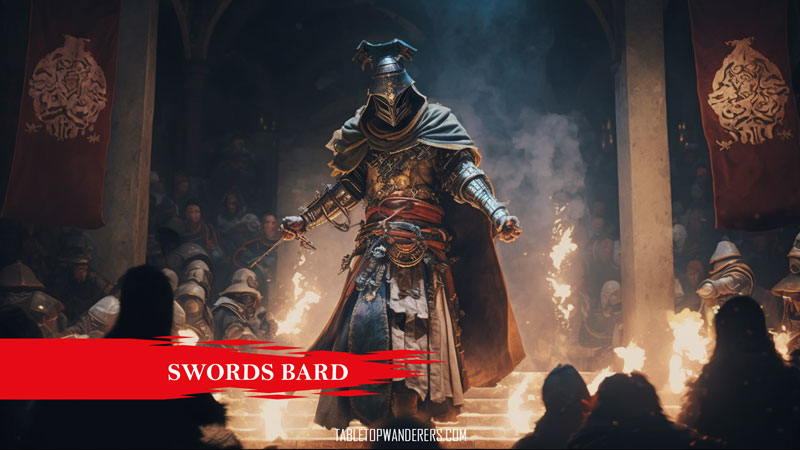
Subclass Overview
Blades, as the bards of the College of Swords are called, mesmerize audiences with daring demonstrations of their mastery of various weapons.
They are excellent and well-trained fighters in their own right, even if they utilise their weapons for entertainment.
They either accept employment as enforcers for thieves’ guilds or set out on their own as adventures using their weapon abilities and magic.
D&D Manual: Xanathar’s Guide to Everything.
Swords Bard Main Features
Bonus Proficiencies – 3rd level
You gain proficiency with medium armour and the scimitar. If you’re also proficient with a simple or martial melee weapon you can use it as a spellcasting focus.
Fighting Style – 3rd level
You can choose a fighting style among 2 options:
- Dueling: when you wield a melee weapon in one hand and no other weapons, you gain +2 to damage rolls.
- Two-Weapong Fighting: when you attack with 2 weapons you can add the ability modifier to the second attack.
Blade Flourish – 3rd level
When you attack your walking speed increases by 10 feet and if you successfully hit a creature you can immediately use of the Blade Flourish effects:
- Defensive Flourish: you can use one of your Bardic Inspiration dice to increase the amount of damage dealt to the target. The damage is equal to the result of your Bardic Inspiration die roll. The result of the roll is also added to your AC until the beginning of your next turn.
- Slashing Flourish: you can spend one use of your Bardic Inspiration dice to increase the damage your weapon does to the target it strikes as well as any other creature you choose that is within 5 feet of you and that you can see. The damage is equal to the result of your Bardic Inspiration die roll.
- Mobile Flourish: you can use one of your Bardic Inspiration dice to increase the amount of damage dealt to the target. The damage is equal to the result of your Bardic Inspiration die roll. You can also push the target 5 feet away from you + the number you rolled with the Bardic Inspiration die. Lastly, you can then move to an unoccupied space within 5 feet of the target using your reaction.
Extra Attack – 6th level
Whenever you take the attack action, you can attack twice rather than once.
Master’s Flourish – 14th level
Any time you use a Blade Flourish skill, you can roll a d6 instead of using a Bardic Inspiration die.
Party Role
Offensive Support.
College of Valor Bard 5e
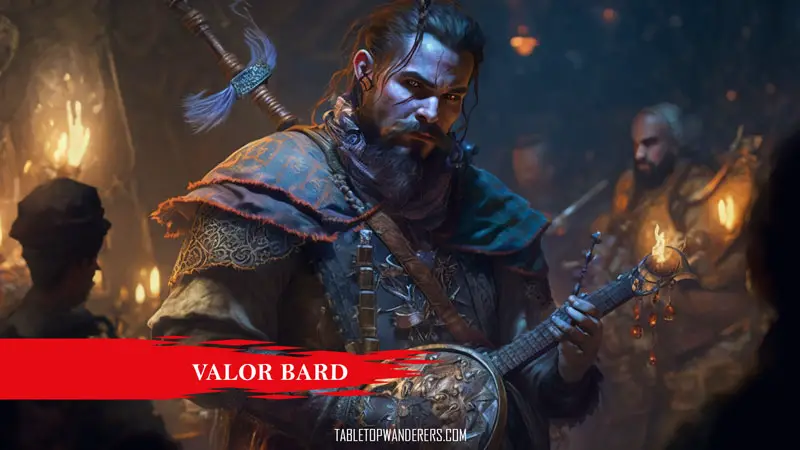
Subclass Overview
Daring poets known as bards of the College of Valor tell tales that inspire future generations of heroes by preserving the memory of earlier great heroes.
They travel the world to ensure the memory of those heroes is preserved and they encourage people to achieve the same levels of success through their songs.
D&D Manual: Player’s Handbook.
Valor Bard Main Features
Bonus Proficiencies – 3rd level
You gain proficiency with medium armour, shields and martial weapons.
Combat Inspiration – 3rd level
Anybody who has one of your Bardic Inspiration dice can roll it and add the number to the weapon damage roll. Or, if attacked, that creature can roll the Bardic Inspiration die and add the number to its AC against that attack.
Extra Attack – 6th level
Whenever you take the attack action, you can attack twice rather than once.
Battle Magic – 14th level
Whenever you use an action to cast a bard spell, you can also make a weapon attack as a bonus action.
Party Role
Offensive Support.
College of Whispers Bard 5e
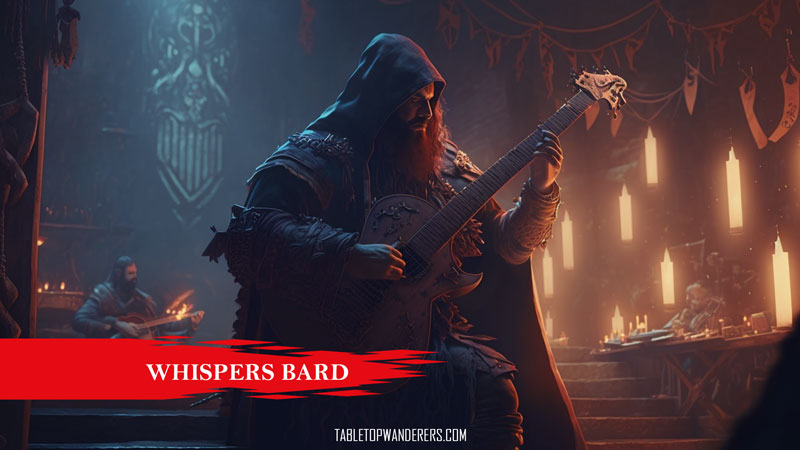
Subclass Overview
The majority of people are delighted to have a bard among them and the College of Whispers’ bards are masters in taking advantage of this situation.
They blend among the people hiding behind a layer of false normality and sing songs or share news like any other bard, but in reality, their aim is to find secrets to utilise against others through extortion and threats.
This is the reason why most bards that come from the College of Whispers have a bad reputation and they rarely reveal their true nature.
D&D Manual: Xanathar’s Guide to Everything.
Whispers Bard Main Features
Psychic Blades – 3rd level
Once per round when you hit a creature with a weapon attack you can decide to use one of your Bardic Inspiration dice to inflict 2d6 extra psychic damage to that target.
Words of Terror – 3rd level
If you speak alone to a humanoid creature for at least 1 minute, you can try to instil paranoia in its mind.
If your target fails a saving throw, it’ll be frightened by you or any other creature of your choice for 1 hour.
Mantle of Whispers – 6th level
When a humanoid creature dies within 30 feet of you, you can use your reaction to capture its shadow and keep it until you want to use it or until you make a long rest.
When you want to use it, the shadow magically creates a disguise allowing you to look like the dead creature that shadow belonged to.
On top of that, you can also draw from that person’s memories to obtain personal information or make your disguise more believable in other people’s eyes.
Shadow Lore – 14th level
Using an action in your turn, you can magically whisper a word that is only audible to one creature of your choice within 30 feet of you.
If the target understands your language and fails a WIS saving throw, it is charmed by you and it’ll obey your commands for fear that you’ll reveal its most mortifying secrets.
Party Role
Crowd control and offensive support.
D&D Bard 5e Subclasses Ranked
Here we are at the end of the article to wrap everything up.
After the brief overview of each Bard 5e subclass, I’d like to put a number next to each one of them in order to create a personal rank.
As I said at the beginning of the article this rank takes into consideration multiple factors and not just the actual strength:
8th • College of Swords Bard: a good bard is a versatile bard, and this subclass only limits the character to an offensive role that doesn’t help support the group as a bard should. Your Bardic Inspiration dice will be consumed to fuel offensive skills that won’t deal nearly enough damage to justify the use of those precious dice.
7th • College of Spirits Bard: there’s always a subclass that includes a high percentage of randomness, and for the Bard, this is the chosen one. This subclass’ main mechanic revolves around rolling the Bardic Inspiration die on the Spirit Tales table and praying for the desired effect. Not a fan of randomness, at all.
The feature Spirit Session is, on the other hand, very powerful but if you take that feature and add it to Mystical Connection (less randomness out of the Spirit Tales table) I think they’re still not enough to justify a higher position in the ranks.
6th • College of Whispers Bard: the idea and flavour of this subclass are very interesting if you want to create an evil character that excels in sessions where there is little or no combat and the campaign revolves mainly around investigating. Outside of the mentioned comfort zone in which this subclass could shine, the Whispers Bard isn’t a good option to choose if you want a character that supports the party.
5th • College of Valor Bard: this subclass is a solid choice if you want a balanced bard who can deal good damage. Medium armour and shield skills increase the character’s AC, which is very useful if you want to throw yourself into the middle of a battle.
Wielding a weapon and shield for a spell caster is very complicated, so you are almost required to get the War Caster feat in order to be more efficient in combat.
Very useful subclass if your party is small and requires more offensive power.
4th • College of Creation Bard: I love the concept behind this subclass. You can create objects out of nowhere, like a stone wall to block your enemies or you can animate objects, like a kitchen pan that will fight alongside you or a flying carpet that carries you in mid-air. This subclass is incredibly fun and it allows you to shake things up and transform a normal D&D session into something unique.
There are some obvious limitations to your creativity though and this is why this class isn’t in one of my top 3 spots.
3rd • College of Glamour Bard: if you love the idea of having a bard that can charme other people, this subclass is tailored to you. With Mantle of Majesty, you can basically cast command as a bonus action without consuming spell slots, which is quite impressive.
Since your gameplay will mostly revolve around charming other creatures you’ll have to learn the correct timing to set things up, but once you get a hold of it you’ll be pretty damn useful to your party.
2nd • College of Lore Bard: this subclass is a very solid choice for whoever wants a versatile bard that is useful since low levels. Thanks to its features you can build a character that boosts its offensive strength by choosing powerful spells or perhaps mitigate its weaknesses, based on your party’s members.
Perfect subclass to choose if you want a balanced character that perfectly blends in with any party and which also gives you some challenges as it’s not the easiest subclass to play.
1st • College of Eloquence Bard: do you want to know what a Bard on steroids looks like? Look no further, the College of Eloquence Bard is the answer. This subclass has everything you could ask for from a support character: it buffs two important skill checks, debuffs enemies’ saving throws and boosts Bardic Inspiration dice.
If I had to choose from any of the Bard 5e subclasses I would always want to have an Eloquence Bard in my party.